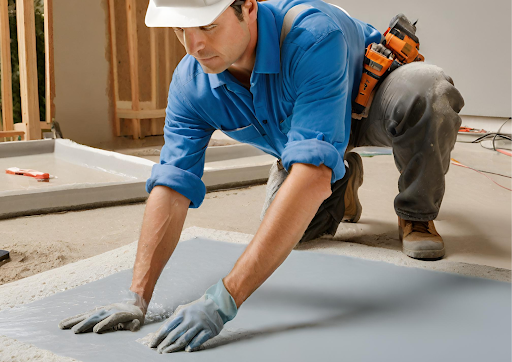Do You NEED to Waterproof Cement Board?
Well, that depends. For walls, especially in showers or areas that get a lot of splashes, waterproofing is a no-brainer. Think of it like an umbrella for your cement board – it keeps the real downpour from getting through and messing up the good stuff behind the wall.
But for floors or areas with minimal water exposure, you might be okay skipping the waterproofing step. Just check with your local building code to see if there are any specific requirements in your area.
So, How Do I Waterproof This Thing?
There are two main ways to waterproof your cement board, and both are pretty straightforward:
- Liquid Membrane: This is like painting on a shield for your cement board. Grab a liquid waterproofing product (available at most hardware stores) and give those boards a good coat, following the manufacturer’s instructions. Think two to three coats for ultimate protection.
- Sheet Membrane: This is basically a sticky waterproof sheet you apply directly to the cement board. Just make sure all the overlaps are sealed tight to create a continuous barrier.
Pro Tip: No matter which method you choose, don’t forget about the seams between the cement boards! Use waterproofing mesh tape and sealant to create a watertight seal.
Remember: Always follow the manufacturer’s instructions for your chosen waterproofing product. Different brands might have slightly different application processes.
Bonus Round: Sealing the Deal!
Once your waterproofing is all cured and dry, don’t forget to caulk around areas like your shower pan or tub deck. This extra layer of protection helps prevent water from sneaking in around the edges.
Waterproofing your cement board might seem like a hassle, but trust me, it’s way easier (and cheaper) than dealing with water damage down the line. So grab your supplies, channel your inner DIY master, and keep your bathroom (or kitchen) oasis leak-free!
Get in Touch
While waterproofing cement board ain’t rocket science, there are some definite perks to calling in a pro. These dudes (or dudettes) do this for a living, so they’ve got the experience and know-how to get the job done right the first time. Messing up waterproofing can lead to major headaches down the road, like moldy walls or leaky showers.
A pro will ensure all the seams are sealed tight, the corners are covered, and basically, your whole waterproof shield is flawless. Plus, they’ll likely have the fancy tools and experience to tackle trickier situations like waterproofing around pipes or drains. So, if you’re feeling a little out of your DIY depth, don’t be afraid to call in the reinforcements and keep your bathroom oasis a stress-free zone!
Related Blog Posts:
- How Long Does the Restoration Process Take for Homes With Water Damage?
- What to Do If Your Home Has Water Damage?
- Signs of Water Damage in the Basement Walls
- Water Damage & Mold: Everything You Need To Know in 2023
- Things You Should Know About Water Damage
- Who Do I Call After My House Has Water Damage Restore?
- What Causes Water Damage to Floors and Walls
Related Services:
Our service areas:
Get A Free Estimate

